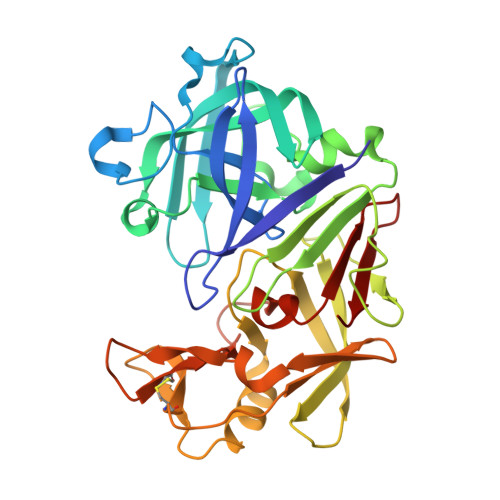A small nonrule of 3 compatible fragment library provides high hit rate of endothiapepsin crystal structures with various fragment chemotypes.
Koster, H., Craan, T., Brass, S., Herhaus, C., Zentgraf, M., Neumann, L., Heine, A., Klebe, G.(2011) J Med Chem 54: 7784-7796
- PubMed: 21972967
- DOI: https://doi.org/10.1021/jm200642w
- Primary Citation of Related Structures:
3PB5, 3PBD, 3PBZ, 3PCW, 3PGI, 3PI0, 3PLD, 3PLL, 3PM4, 3PMU, 3PMY - PubMed Abstract:
Druglike molecules are defined by Lipinski's rule of 5, to characterize fragment thresholds, they have been reduced from 5 to 3 (Astex's rule of 3). They are applied to assemble fragment libraries, and providers use them to select fragments for commercial offer. We question whether these rules are too stringent to compose fragment libraries with candidates exhibiting sufficient room for chemical subsequent growing and merging modifications as appropriate functional groups for chemical transformations are required. Usually these groups exhibit properties as hydrogen bond donors/acceptors and provide entry points for optimization chemistry. We therefore designed a fragment library (364 entries) without strictly applying the rule of 3. For initial screening for endothiapepsin binding, we performed a biochemical cleavage assay of a fluorogenic substrate at 1 mM. "Hits" were defined to inhibit the enzyme by at least 40%. Fifty-five hits were suggested and subsequently soaked into endothiapepsin crystals. Eleven crystal structures could be determined covering fragments with diverse binding modes: (i) direct binding to the catalytic dyad aspartates, (ii) water-mediated binding to the aspartates, (iii) no direct interaction with the dyad. They occupy different specificity pockets. Only 4 of the 11 fragments are consistent with the rule of 3. Restriction to this rule would have limited the fragment hits to a strongly reduced variety of chemotypes.
Organizational Affiliation:
Department of Pharmaceutical Chemistry, Philipps University Marburg, Marbacher Weg 6, 35032 Marburg, Germany.

















